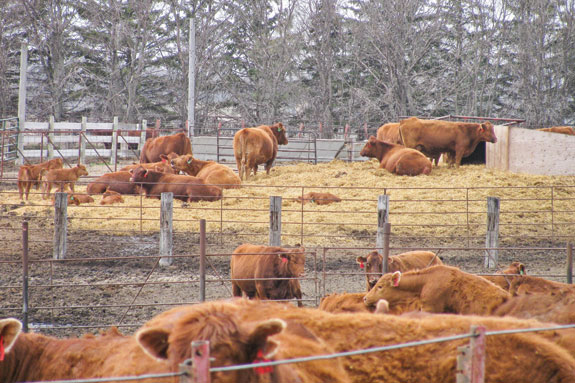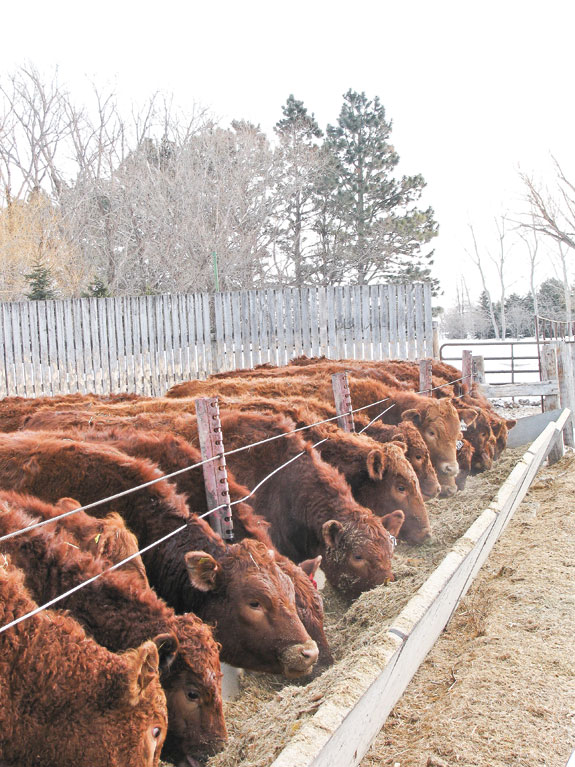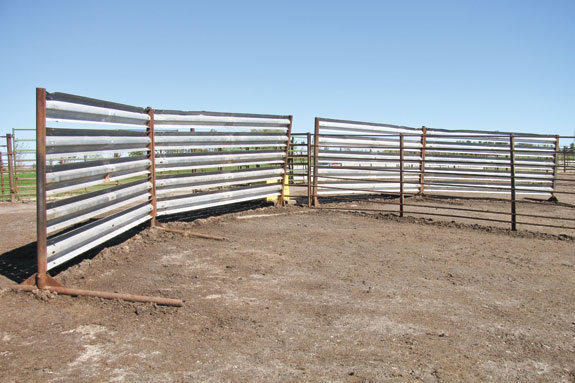As hot as 2011 was for much of the cattle industry, the harsh conditions of winter can be yet another threat to the bottom line.Vern Anderson, an animal scientist with over 30 years experience from the Carrington Research Extension Center at North Dakota State University, explains how to prepare feedlots for winter and maintain them throughout the season and into the spring thaw.
As the season begins to change and temperatures drop, cattle will adapt. Their hair will grow in thicker and their appetite will also increase to help keep them warm.
There will be some periods of extreme cold that may cause stress on the cattle, but it is up to the manager to decrease that stress so cattle will be more efficient and healthy.

Shelterbelts, trees and fences
In order to reduce stress from cold, wind and snow, you can provide wind protection with shelterbelts and also sloping the pen area.
“Ideally, we like to have three belts separated by 100 feet in order to catch drifting snow,” Anderson says. “This provides wind protection, catches snow and reduces removal from pens.”
The first line of defense against wind and blowing snow will be a tree belt, or living wind protection. Having a tree belt is worth a quarter-pound of gain per day.
When you first plant a tree belt it may take a few years to reach full effectiveness, but it will also last 30 to 40 years.
If you can’t grow trees, a second line of defense would be a porous wood to reduce wind and blowing snow.
The cattle will tuck behind these guards, which create a more comfortable environment. If you have a 10-foot wind fence, it can offer up to 100 feet of protection.
Wind fences can be made out of virtually anything you can get to stand upright. “I’ve even seen them made out of metal guardrails and tires,” Anderson says.
Jay Mathern, owner of Mathern Cattle Company in Edgeley, North Dakota, says he uses tin metal and living wind protection on his pasture for his cattle.
The methods of wind protection on Mathern’s pasture are set up in increments, roughly every 50 feet.
Slopes and bedding
Sloping property is another significant line of defense. “Every degree of slope to the south increases solar radiation and is the equivalent of moving the herd about 70 miles to the south,” Anderson says. “A 4º slope is the equivalent of moving your cattle 280 miles south.”

Bedding also keeps cattle healthy during the winter. According to Anderson, bedding can be worth up to $80 per animal in terms of improving performance, carcass quality and manure nutrient value.
Bedding brings carbon into the pen and absorbs nutrients in the frozen ground such as nitrogen and phosphorus.
“Whether you spread the manure raw or compost it, we’ve found that when bedding is involved it limits volatilization of nitrogen by creating microbes that will stabilize the nitrogen and essentially sequester it,” Anderson says.
Bedding amount is fairly subjective. “We’ve seen bedding knee-deep, but just keeping the cattle off the frozen ground with a not-so-generous portion helps out a lot,” Anderson says.
Continuity of bedding is more important. In modern feedlot rations where forage is extremely limited, any time you start bedding you have the cattle nibbling on the bedding.
“If you bed infrequently you’ll get some cycling up and down of feed intake, which can cause digestive upsets,” Anderson says.
Mark Malecek, owner of Malecek Feedlot in Redwood Falls, Minnesota, says his most important step for prepping his feedlot for winter is managing his bedding for his 500+ head operation.
“Another important step is our usage of round bales and positioning them correctly to shelter our cattle from the prevailing winds,” Malecek says.
Separating the meals
Having a little extra forage in the cattle’s diet to keep them from eating the bedding is a good idea. The type of bedding material you use can solve part of the problem.
“We’ve used cereal straw, wheat straw and barley straw,” Anderson says. “We’ve also used corn stover and soybean residue, and all of them are useful – although cattle seem to eat more of the corn stover and reduce the intake of their finishing ration, and we’ve seen a slight decrease in performance when using corn stover as bedding.”

According to Anderson, corn stover consumption can have a soothing effect on the pH in the rumen, but he would not recommend it as a bedding material.
In some cases where typical bedding was not readily available, sawdust and shredded paper can be used.
When feeding cattle, as long as you do not exceed 55 percent moisture, you will keep cattle on a healthy diet.
“We have not seen a large decrease in intake or performance as long as there isn’t too much moisture content,” Anderson says.
The best time of day to add new bedding is after cattle eat and get their fill in the morning to prevent consumption of the bedding.
When weaned calves arrive during this time, you may put them in a receiving pen to provide more protection and easier access to feed and water.
It is important to keep new cattle separate to avoid disease or spreading infection.
Water, snow and ice
Another step Malecek mentions is monitoring the water source for his cattle. “It’s important to make sure the temperature is not freezing or too warm so bacteria can build up.” Malecek will usually keep a hose running at a slow rate.
If at all possible, it is best to remove snow and ice as soon as it accumulates. That being said – be sure to have all your equipment ready to go for the season.
Ice should be removed around all the bunks and water fountains. You should also make sure the water is drinkable.
“We typically do not recommend that cattle are housed inside during long periods of time and, if they are, then ventilation can become a critical factor,” Anderson says.
“Bringing in cattle to work on for a short period will not have an effect. But when cattle are packed in for a longer period, you need to find a way to release the humidity.”
Cattle are extremely tolerable of cold conditions. Hypothermia and frostbite rarely occur, except in calving periods with exposure to ears or tails.
Poor insulation mixed with a new cold and wet environment may have a risk of hypothermia for some newly delivered cattle.
According to Anderson, when temperatures reach 20 or 30 degrees below zero, it’s best to hold off on shipping cattle.
Cattle tend to drink less in extreme cold and if you wait for manageable temperatures, cattle will rehydrate and show better.
If you do ship cattle, make sure the truck is covered to protect cattle from cold winds that may cause frostbite.
When the spring thaw begins, pile your ice and snow from the pens in an area where the runoff will enter the containment facility.
This will keep the manure and nutrients in the snow from contaminating the state waters. ![]()
PHOTOS
Top: Cattle will grow longer hair in winter months but still need some protective structure on a feedlot to keep them warm.
Middle Top:These pens offer not only a shelterbelt of trees in the background, but some sloping under the sun and fresh bedding for additional warmth to the cattle.
Bottom Top: By adding more forage to cattle’s winter diet, you can prevent them from eating bedding.
Bottom: A metal wind fence, like these, can add a significant amount of protection for cattle on the feedlot. Photos courtesy Carrington Research Extension Center







